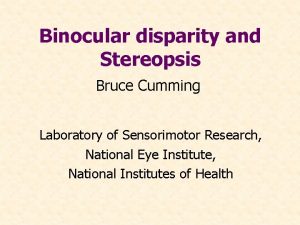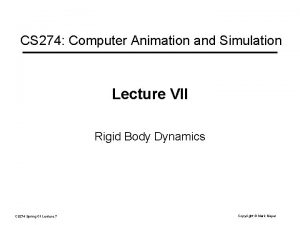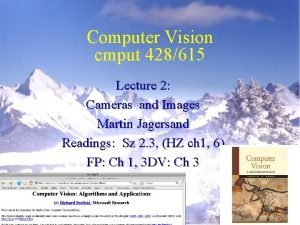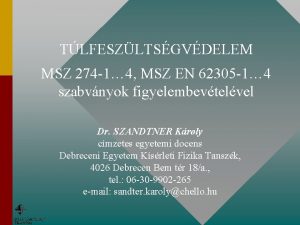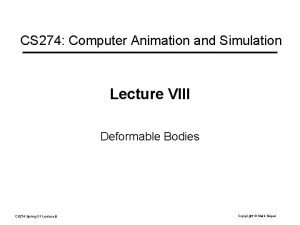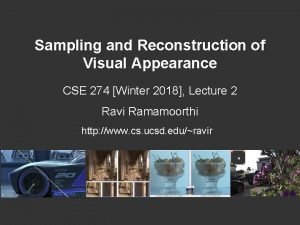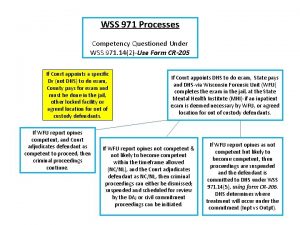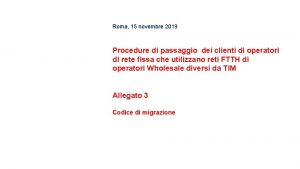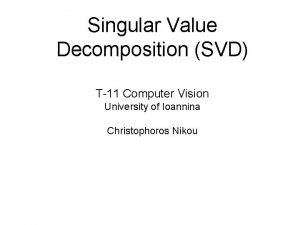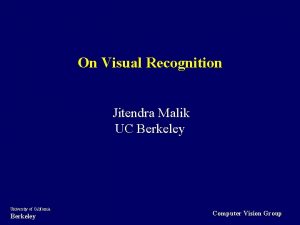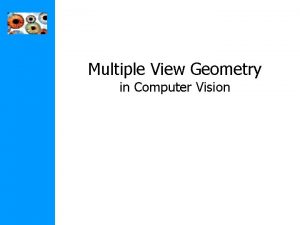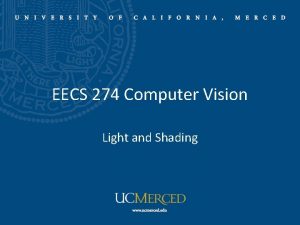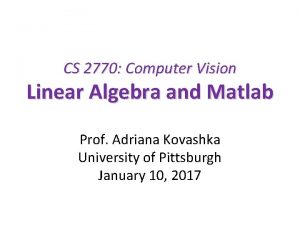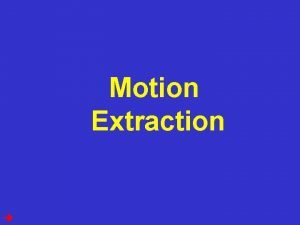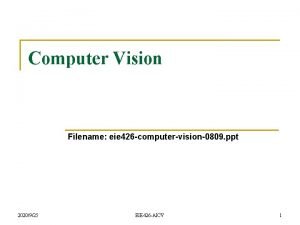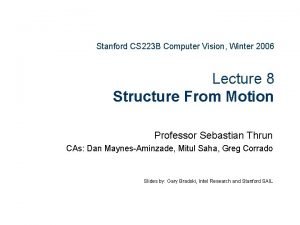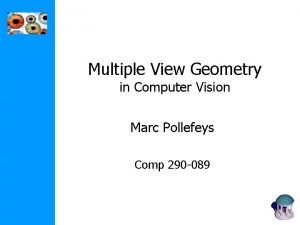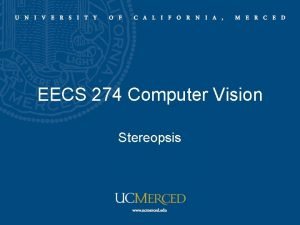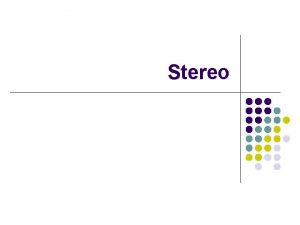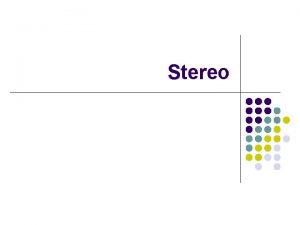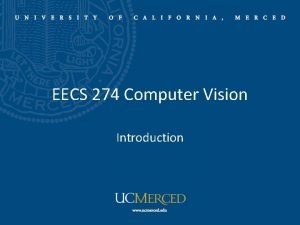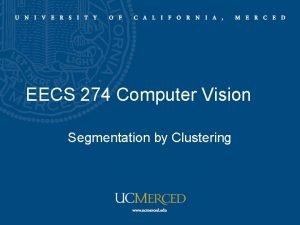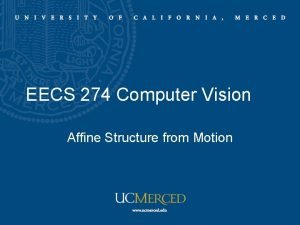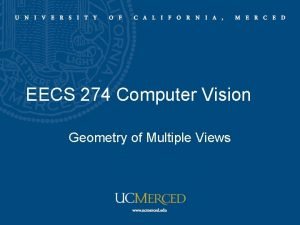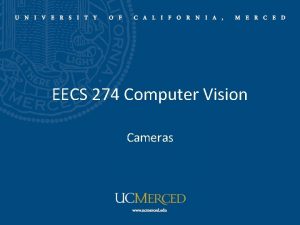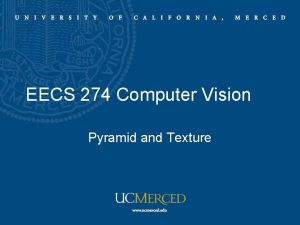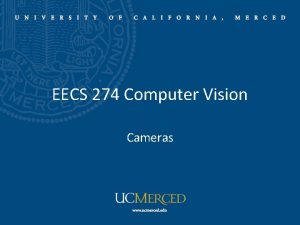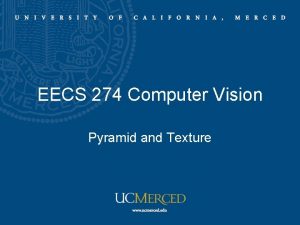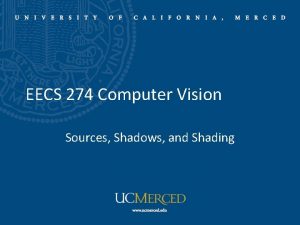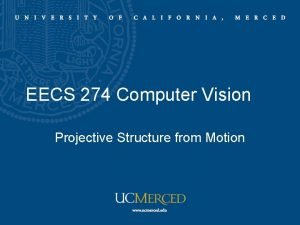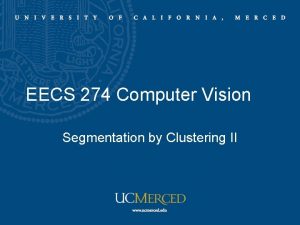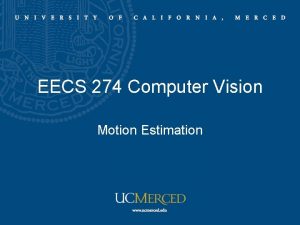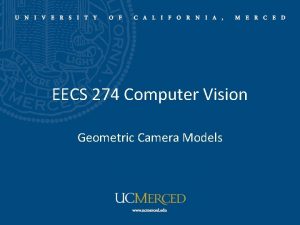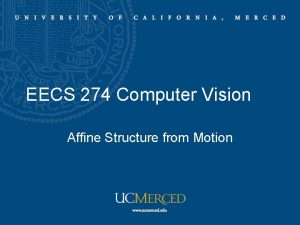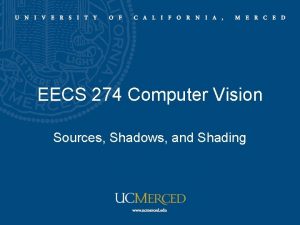EECS 274 Computer Vision Stereopsis Stereopsis Stereopsis Fusion
























- Slides: 24

EECS 274 Computer Vision Stereopsis

Stereopsis • • • Stereopsis: Fusion and Reconstruction Correlation-Based Fusion Multi-Scale Edge Matching Dynamic Programming Using Three or More Cameras Reading: FP Chapter 11, S Chapter 11

An application: mobile robot navigation The INRIA Mobile Robot, 1990. The Stanford Cart, H. Moravec, 1979. Courtesy O. Faugeras and H. Moravec.

Stereo vision • Fusion: match points observed by two or more cameras • Reconstruction: find the pre-image of the matching points in 3 D world • Assume calibrated camera and essential matrix/trifocal tensors associated with 3 cameras are known

Reconstruction / triangulation

(Binocular) Fusion

Reconstruction Geometric approach • Linear Method: find P such that • Non-Linear Method: find Q minimizing Algebraic approach

Rectification All epipolar lines are parallel in the rectified image plane

Reconstruction from rectified images Disparity: d=u’-u Depth: z = -B/d × f

Correlation methods (1970 --) Slide the window along the epipolar line until w. w’ is maximized. 2 Normalized Correlation: minimize q instead. Minimize |w-w’|

Correlation methods: foreshortening problems Solution: add a second pass using disparity estimates to warp the correlation windows, e. g. Devernay and Faugeras (1994)

Multi-scale edge matching (Marr, Poggio and Grimson, 1979 -81) • Edges are found by repeatedly smoothing the image and detecting the zero crossings of the second derivative (Laplacian) • Matches at coarse scales are used to offset the search for matches at fine scales (equivalent to eye movements)

Multi-scale edge matching (Marr, Poggio and Grimson, 1979 -81) One of the two input images Image Laplacian Zeros of the Laplacian

Multi-scale edge matching (Marr, Poggio and Grimson, 1979 -81)

The ordering constraint In general the points are in the same order on both epipolar lines. But it is not always the case. .

Ordering constraints points are not necessarily in order d-b-a c’-b’-d’

Dynamic programming (Baker and Binford, 1981) Find the minimum-cost path going monotonically down and right from the top-left corner of the graph to its bottom-right corner. • Nodes = matched feature points (e. g. , edge points). • Arcs = matched intervals along the epipolar lines. • Arc cost = discrepancy between intervals.

Dynamic programming (Ohta and Kanade, 1985) use inter-scanline f or point correspondence on vertical edges use DP for both intra-scanline and inter-scanline search

Three views The third eye can be used for verification. . b 1 -a 2 match is wrong as thee is no corresponding point in camera 3

More views (Okutami and Kanade, 1993) Pick a reference image, and slide the corresponding window along the corresponding epipolar lines of all other images, using inverse depth relative to the first image as the search parameter. Use the sum of correlation scores to rank matches.

I 1 I 2 I 10

Correspondence • Extensive literature – Region based – Graph cut – Mutual information – Belief propagation – Conditional random field • Smooth surfaces

Middlebury stereo dataset • De facto data set with ground truth, code, and comprehensive performance evaluation • http: //vision. middlebury. edu/stereo/data/

Performance evaluation
 Stereopsis
Stereopsis Structured light
Structured light Fresco y mas 274
Fresco y mas 274 Cs 274
Cs 274 Cmput 274
Cmput 274 Msz 62305
Msz 62305 Cs-274
Cs-274 Cse 274
Cse 274 Rct-274
Rct-274 Wss 274
Wss 274 Delibera 274 tim
Delibera 274 tim 16-385 cmu
16-385 cmu Kalman filter computer vision
Kalman filter computer vision T11 computer
T11 computer Berkeley computer vision
Berkeley computer vision Multiple view geometry in computer vision.
Multiple view geometry in computer vision. Face detection viola jones
Face detection viola jones Radiometry in computer vision
Radiometry in computer vision Linear algebra for computer vision
Linear algebra for computer vision Impoverished motion examples
Impoverished motion examples Computer vision models learning and inference
Computer vision models learning and inference Watershed segmentation
Watershed segmentation Cs223 stanford
Cs223 stanford Multiple view geometry in computer vision
Multiple view geometry in computer vision Python cognitive services
Python cognitive services
